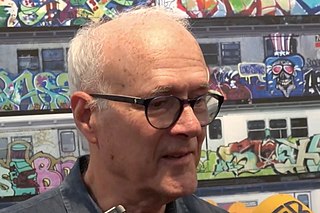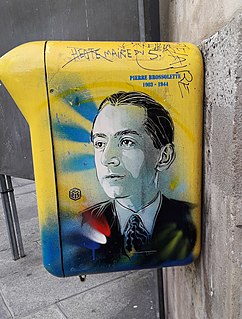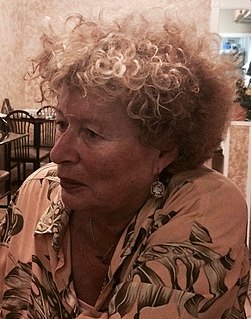
Ben Shahn was an American artist. He is best known for his works of social realism, his left-wing political views, and his series of lectures published as The Shape of Content.

Henry Chalfant is an American photographer and videographer most notable for his work on graffiti, breakdance, and hip hop culture.

Street art is visual art created in public locations for public visibility. It has been associated with the terms "independent art", "post-graffiti", "neo-graffiti" and guerrilla art.
Lady Pink, born Sandra Fabara (1964), is an Ecuadorian-American graffiti and mural artist.

Crash is a graffiti artist.

Elsie Driggs was an American painter known for her contributions to Precisionism, America's one indigenous modern-art movement before Abstract Expressionism, and for her later floral and figurative watercolors, pastels, and oils. She was the only female participant in the Precisionist movement, which in the 1920s and 1930s took a Cubist-inspired approach to painting the skyscrapers and factories that had come to define the new American landscape. Her works are in the collection of the Whitney Museum of American Art, the Houston Museum of the Fine Arts, the Fine Arts Museums of San Francisco, the James A. Michener Art Museum in Pennsylvania, and the Columbus Museum of Art, among others. She was married to the American abstract artist Lee Gatch.

Chakaia Booker is an American sculptor known for creating monumental, abstract works for both the gallery and outdoor public spaces. Booker’s works are contained in more than 40 public collections and have been exhibited across the United States, Europe, Africa, and Asia. Booker was included in the 2000 Whitney Biennial, received a Guggenheim Fellowship in 2005, and an American Academy of Arts and Letters Award for Art in 2001. Booker has lived and worked in New York City’s East Village since the early 1980s and maintains a production studio in Allentown, Pennsylvania.

José Parlá, is a Brooklyn-based contemporary artist whose work has been described as "lying between the boundary of abstraction and calligraphy."
Philemona Williamson is an artist from New York City.
Alex Brewer, also known as HENSE, is an American contemporary artist, best known for his dynamic, vivid and colorful abstract paintings and monumental wall pieces. He has been active since the 1990s. In 2002 he began accepting commissions for artwork and over the course of the last decade has established a solid reputation as a commissioned artist, having appeared in several solo and group shows.

MadC is a graffiti writer and muralist. She was born in Bautzen, Germany, and is most known for her large-scale, outdoor artistic paintings.

Shamsia Hassani is an Afghan graffiti artist, a fine arts lecturer, and the associate professor of Drawing and Anatomy Drawing at the Kabul University. She has popularized "street art" in the streets of Kabul and has exhibited her art in several countries including India, Iran, Germany, United States of America, Switzerland, Vietnam, Norway, Denmark, Turkey, Italy, Canada, and in diplomatic missions in Kabul. Hassani paints graffiti in Kabul to bring awareness to the war years. In 2014, Hassani was named one of FP's top 100 global thinkers.
Alicia McCarthy is an American painter. She is a member of San Francisco's Mission School art movement. Her work is considered to have Naïve or Folk character, and often uses unconventional media like housepaint, graphite, or other found materials. She is currently based in Oakland, California.
Cynthia Mailman is an American painter and educator. She is known for figurative and landscape works done in a "cool, pared-down" style. Her early paintings were presented from a perspective inside the artist's VW van, looking outward, and include mirrors, wipers or other interior elements against the exterior landscape. By doing this, Mailman put the observer in the driver's seat, which is also the artist's point of view. According to Lawrence Alloway, "The interplay of directional movement and expanding space is a convincing expansion of the space of landscape painting".
Dahlia Elsayed is a New York-based painter, writer, and teaching artist whose work explores the relationships between language and landscape. Her work has won awards and been shown at galleries and art institutions internationally.

Priscila De Carvalho is a Brazilian-born American contemporary artist who is known for paintings, sculptures, murals, site-specific art installations, and permanent public art.

Inverna Lockpez is a Cuban American painter, sculptor, and activist, that participated in the second wave of America's feminist movement. She is known for her graphic novel Cuba: My Revolution, a fictionalized memoir of her life prior to coming to the United States.
Elizabeth Thompson is an American painter whose works have been described by writer and art historian Bonnie Clearwater as "a call to action for the reclamation of Paradise". She has painted the Florida Everglades as "de-peopled visions of a primordial Eden." Thompson lives in Florida and New York City.
The Fun Gallery was an art gallery founded by Patti Astor and Bill Stelling in 1981. The Fun Gallery had a cultural impact until it closed in 1985. As the first art gallery in Manhattan's East Village, it exposed New York to the talents of street art by showcasing graffiti artists like Fab 5 Freddy, Futura 2000, Lee Quiñones, Zephyr, Dondi, Lady Pink, and ERO. Contemporary artists Kenny Scharf, Jean-Michel Basquiat, and Keith Haring also had solo exhibitions at the Fun Gallery.

Ryah Ludins (1896–1957) was a Russian-born American muralist, painter, printmaker, art teacher, and writer. She made murals for post offices and other government buildings during the Great Depression and also obtained commissions for murals from Mexican authorities and an industrial concern. Unusually versatile in her technique, she made murals in fresco, mixed media, and wood relief, as well as on canvas and dry plaster. She exhibited her paintings widely but became better known as a printmaker after prints such as "Cassis" (1928) and "Bombing" drew favorable notice from critics. She taught art in academic settings and privately, wrote and illustrated a children's book, and contributed an article to a radical left-wing art magazine. A career spanning more than three decades ended when she succumbed to a long illness in the late 1950s.












